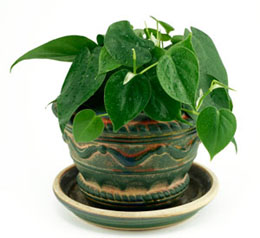Caring for a philodendron is all about providing the plant its favorable growth conditions. Philodendrons are however, not very difficult to grow. Find out more about these plants, and how to care for them through this Buzzle article.
 Philodendron
Philodendron is a genus of flowering plants, which are native to the regions of tropical America and West Indies. There are approximately 400 to 700 species of philodendron plants, which are the members of the plant family,
Araceae (the arum family). In fact, philodendron is the second largest member of the arum family. The word, philodendron is actually derived from two Greek words - 'philo', which means love, and 'dendron', which means tree'.
The plants of this genus mainly grow in the tropical forests, swamps, as well as in the river banks. There are basically two types of philodendrons - the climbing variety, and the non-climber. The climbers are quite popular as houseplants, while the non-climbers are more commonly used for outdoor gardens and also for landscaping purposes, as they can attain an enormous size.
Plant Description
The plants of this genus are mainly grown as ornamental plants for their striking foliage. The variety that is more commonly grown as houseplant is the heart-shaped philodendron. As the name suggests, the leaves of this plant are heart-shaped, and are glossy and deep green in color. The leaves of the philodendron 'Brasil' are variegated.
The shape and color of these plants can thus, differ a lot. But in general, the leaves are heart-shaped, oblong or ovate, deep-lobed, long and narrow, or pinnate. A few species have also been observed to possess arrow-shaped leaves. Some species can produce red or copper red-colored leaves that turn green at maturity.
Another interesting quality of these plants is that the same plant can produce two different types of leaves, which are known as juvenile and adult leaves. The adult leaves are usually larger than the juvenile leaves, and they also differ in shape. This created a lot of taxonomic difficulties in the past leading to the classification of the juvenile and the adult plants as two different species. Many species like the tree philodendron and the split-leaf philodendron produce blossoms when they mature. The flowers of these plants resemble calla lilies in shape. The flowers can be greenish-white or reddish in color.
Plant Care
For proper care, it is important to have some basic knowledge about the growth conditions that these plants require. Philodendrons are more commonly found in the forests and jungles, as well as in the river banks and swamps. So, they mostly grow in partially-shaded and moist areas in their natural habitats. For this reason, they thrive in bright, but indirect or diffused sunlight. They can also tolerate low light conditions, though it can affect the size of their leaves. But still, compared to many other houseplants, they require less light. If they receive strong direct sunlight, their leaves will burn. The ideal temperature range for growing these plants are, 60 to 72°F.
Philodendrons prefer well-drained and rich soil. So, they can be planted in high quality potting soil. An ideal potting mix can be made by mixing equal amounts of peat moss, sand and loam, and a small amount of charcoal pieces. If you are considering to grow them in pots, then choose a pot that is slightly larger than the root ball of the plant. If needed, repotting can be done, when the root grows to wrap around the bottom of the pot. Repotting can be done once in a year during late winter or early spring, i.e., before the growing season. Place some stakes in the pots to provide support to the plant, if it is a climbing variety.
Philodendrons require moist soil to thrive. So, regular watering is very important for growing healthy plants. However, over-watering can lead to yellowing of the leaves. Therefore, be sure to water them only when the top layer of the soil is dry. But do not wait for the entire soil to dry out. In general, watering once in a week is sufficient. These plants grow in a humid environment in their natural habitats. Therefore, misting at regular intervals can ensure better health. They usually do not require much feeding. However, you can use an all-purpose fertilizer if needed. It is better to dilute the fertilizer before applying it.
If grown properly, they can be excellent for home and office decor. The climbing varieties can look specially amazing in hanging baskets. However, these plants are toxic. They contain calcium oxalate crystals, which can produce a burning sensation in the mouth, and cause swelling of the tongue, mouth, and the esophagus, if you happen to ingest or chew the plant parts. These plants are also toxic to some animals, and so, it is better to keep your pets away from these plants.






 Philodendron is a genus of flowering plants, which are native to the regions of tropical America and West Indies. There are approximately 400 to 700 species of philodendron plants, which are the members of the plant family, Araceae (the arum family). In fact, philodendron is the second largest member of the arum family. The word, philodendron is actually derived from two Greek words - 'philo', which means love, and 'dendron', which means tree'.
Philodendron is a genus of flowering plants, which are native to the regions of tropical America and West Indies. There are approximately 400 to 700 species of philodendron plants, which are the members of the plant family, Araceae (the arum family). In fact, philodendron is the second largest member of the arum family. The word, philodendron is actually derived from two Greek words - 'philo', which means love, and 'dendron', which means tree'.